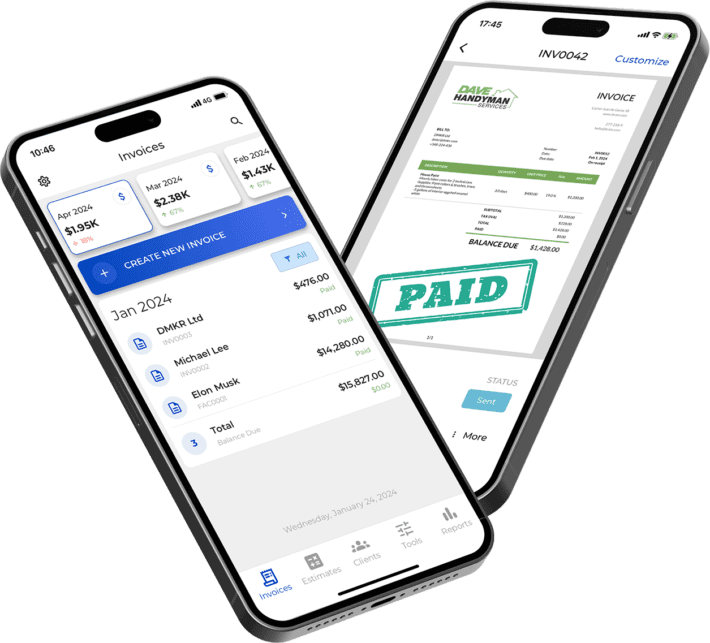What Is An ACH Payment & How Do ACH Transfers Work?

Table of Contents
- What is the Automated Clearing House (ACH) network?
- What are ACH payments?
- How does an ACH transfer work?
- How to make an ACH payment
- ACH transfer types
- ACH vs. Wire transfer
- Is ACH payment safe?
- Pros and cons of ACH for individuals
- Pros and cons of ACH for businesses
- International ACH transfers
- Final Thoughts
- FAQs About ACH Transfers
In order to run a business smoothly, you need to keep your finances organized and efficient. ACH payments are electronic transfers made through the Automated Clearing House network which make it possible to send and receive money directly between bank accounts without relying on paper checks or card payments. They’re fast, secure, and cost-effective, helping businesses simplify payroll, send money to suppliers, and collect payments from customers easily.
In this 2025 guide, we’ll explain how ACH payments work, why understanding them matters for your business, and how you can get started using them to save time, cut costs, and improve your cash flow.
Need a payment processing solution for your small business? Try Invoice Fly’s Invoicing Software!

What is the Automated Clearing House (ACH) network?
The Automated Clearing House (ACH) network is the electronic system that moves money between U.S. bank accounts. Think of it like a digital highway for payments. Instead of writing paper checks or carrying cash, you can send money electronically through this network.
Nacha (the National Automated Clearing House Association) runs the ACH network. They set the rules that all banks, credit unions, and businesses must follow when processing ACH transactions. The actual work of moving money happens through two ACH operators: the Federal Reserve and The Clearing House.
The ACH network is huge. According to Nacha’s 2025 statistics, the network handled 8.7 billion payments worth $23.3 trillion in just the second quarter of 2025. The ACH network runs 23¼ hours every business day and moves money between banks four times daily.
What are ACH payments?
ACH payments are electronic money transfers that move through the ACH network. Instead of handing someone cash or mailing a check, the money moves directly from one bank account to another electronically. This payment method has become essential for both individuals and businesses managing their finances.
There are two main types:
- ACH credits (where you push money to someone, like when your employer deposits your paycheck)
- ACH debits (where someone pulls money from your account with permission, like when you pay a monthly bill).
Common uses of ACH payments
Understanding where ACH payments fit into daily life helps you see why they’re so popular. People and businesses use ACH transfers for lots of everyday transactions:
- Direct deposit payroll — employees get paid automatically
- Bill payments — utility, mortgage, and subscription payments
- Business-to-business payments — paying vendors and suppliers
- Tax refunds — the IRS deposits refunds directly to your account
- Person-to-person transfers — apps like Venmo use ACH behind the scenes
- Online purchases — some e-commerce sites accept ACH payments
Examples of ACH transactions
To make this more concrete, let’s look at some real-world examples of how people use ACH payments every day:
Example 1: Sarah’s employer deposits her $3,000 paycheck every two weeks directly into her checking account. This is an ACH credit transfer.
Example 2: Mike authorizes his electric company to withdraw $120 from his account on the 15th of each month. This is an ACH debit transfer.
Example 3: A small business owner uses ACH to pay a $5,000 invoice to a supplier, avoiding check printing and mailing costs. For more on managing business payments efficiently, check out our complete guide on getting paid as a freelancer or contractor.
How does an ACH transfer work?
Understanding the ACH transfer process helps you know what happens to your money and why it takes a certain amount of time to complete.

The ACH transfer process step-by-step
The ACH process might seem complex, but it follows a clear path from start to finish. Here’s how an ACH payment moves from one account to another:
Step 1: Initiation Someone starts the payment. This could be you paying a bill online or your employer sending payroll.
Step 2: Originating bank collects The originating bank (called the ODFI) collects payment instructions from the person or business starting the transfer. According to Nacha’s process explanation, the ODFI combines multiple ACH requests into batches.
Step 3: ACH operator sorts The batch goes to an ACH operator (Federal Reserve or The Clearing House) who sorts all the transactions and routes them to the correct destination banks.
Step 4: Receiving bank processes The receiving bank (called the RDFI) gets the instructions and either credits money to an account (for deposits) or debits money from an account (for payments).
Step 5: Settlement The actual money moves between banks through the Federal Reserve’s settlement system. The ACH network settles payments four times each business day.
Processing time and settlement
One common myth about ACH transfers is that they take 3-5 days. That’s old information. According to Nacha, about 80% of ACH payments finish in one business day or less.
Standard ACH timing:
- Most ACH transfers complete within 1-2 business days
- Payments started on Monday usually arrive by Tuesday or Wednesday
- Weekend transactions process on the next business day
Same Day ACH: For faster processing, Same Day ACH lets you send and receive payments worth up to $1 million on the same business day. Same Day ACH moves money three times daily during business hours. This option usually costs a bit more but gives you much faster access to funds.
Did You Know? About 80% of all ACH payments in the U.S. settle in one banking day or less — faster than ever before.
How to make an ACH payment
Setting up ACH payments is easier than you might think once you understand what information you need and how the process works. Whether you’re paying bills or collecting payments from customers, getting started takes just a few steps.
Setting up an ACH transfer
Most banks and payment processors let you set up ACH transfers through several methods:
Online banking: Log into your bank account and use the bill pay or transfer feature. You’ll add the recipient’s bank information and authorize the payment.
Payment processors: Services like Invoice Fly’s online payment system let you accept ACH payments from customers easily. These tools handle the technical details for you.
Direct authorization: Give your bank information to companies you want to pay. They’ll set up automatic withdrawals with your permission.
Invoice tools: If you’re a freelancer or small business, you can create professional invoices that include ACH payment options using tools like our free invoice generator.
Information you’ll need
To send or receive an ACH payment, you need several key pieces of information:
- Bank account number — the full account number for the checking or savings account
- Routing number — the 9-digit number that identifies the bank
- Account type — checking or savings
- Bank name — the financial institution’s official name
- Account holder name — the legal name on the account
Always double-check these numbers before submitting. Wrong information can cause delays or send money to the wrong place. For businesses wanting to accept multiple payment types beyond just ACH, learn more about how to accept credit card payments as a contractor.
Get paid faster online with Invoice Fly’s payments software! Try it now.

ACH transfer types
ACH transfers come in two flavors, each serving different purposes in how money moves between accounts. Understanding which type you’re using helps you know what to expect.
ACH credit transfers
ACH credits are when you “push” money from your account to someone else’s account. You start the payment and the money leaves your account. This is the type most people think of when sending money.
Common ACH credit examples:
- Payroll direct deposits
- Tax refunds from the IRS
- Vendor payments from businesses
- Freelancer payments
The sender controls when the money leaves their account. This gives businesses more control over cash flow timing.
ACH debit transfers
ACH debits work the opposite way. Someone “pulls” money from your account with your permission. You give authorization ahead of time, and they start the withdrawal when it’s due.
Common ACH debit examples:
- Monthly bill payments (utilities, mortgage, subscriptions)
- One-time online purchases where you pay by bank account
- Insurance premium collections
- Gym membership fees
You stay in control because you must authorize ACH debits. According to the Consumer Financial Protection Bureau, consumers have rights to revoke authorization and dispute unauthorized debits.
ACH vs. Wire transfer
Both ACH and wire transfers move money electronically, but they work very differently and suit different situations. Knowing when to use each one saves you time and money.

| Feature | ACH Transfer | Wire Transfer |
| Speed | 1–2 business days (or same-day for an extra fee) | Same day, often within hours |
| Cost | Usually $0–$3 per transaction (many are free) | $15–$50 per transfer, sometimes more for international wires |
| Best For | Recurring payments, payroll, regular bills, and large volumes | Urgent payments, large one-time transfers, and real estate transactions |
| Reversibility | Can be reversed within certain time windows | Usually irreversible once sent |
| Limits | Same Day ACH up to $1 million; standard ACH limits vary by bank | Typically higher limits, sometimes unlimited |
Pro Tip: According to Experian, use ACH transfers for regular business payments to save on fees, and reserve wire transfers for urgent or high-value transactions that need to arrive the same day.
Is ACH payment safe?
Security matters when you’re moving money electronically. The good news: ACH transfers are very safe when you follow basic precautions and understand how the system protects your money.
Security measures in ACH transfers
The ACH network has multiple layers of security protecting your transactions:
Encryption: All ACH data is encrypted during transmission, making it hard for hackers to intercept
Authentication: Banks verify account ownership before processing transfers
Nacha Operating Rules: Nacha’s strict rules require all participants to follow security standards
Federal oversight: The Federal Reserve and banking regulators monitor ACH activities
Limited access: Unlike credit card numbers that you share with many merchants, your bank account information goes directly to trusted parties
Common risks and how to avoid them
While ACH is safe overall, you should watch out for these common issues. Here’s what to look for and how to protect yourself:
Phishing scams: Never give your bank information to unsolicited callers or emails claiming to be from your bank. Always contact your bank directly using official numbers.
Unauthorized debits: Check your bank statements regularly. Report unauthorized ACH debits within 60 days to get your money back.
Data breaches: Only share banking information with trusted businesses. Check that websites use HTTPS and legitimate payment processors.
Typos: Double-check account numbers. One wrong digit sends money to the wrong place.
For businesses, understanding how to accept payments securely helps protect both you and your customers.
Get Started with Invoice Fly’s Software
Invoice Fly is a smart, fast, and easy-to-use invoicing software designed for freelancers, contractors, and small business owners. Create and send invoices, track payments, and manage your business — all in one place.

Pros and cons of ACH for individuals
ACH transfers offer clear benefits for personal use, but they also have some limitations you should know about before relying on them completely.
Advantages for personal use
Here’s why millions of Americans use ACH for their everyday banking:
It’s cheap or free: Most banks don’t charge for ACH transfers. Some charge $1-3, which is still much less than money orders or cashier’s checks.
Direct deposit is reliable: Your paycheck arrives on time every payday, even if you’re on vacation. No trips to the bank to deposit checks.
It’s paperless: No more checks to write, stamps to buy, or envelopes to mail. Everything happens electronically.
It’s trackable: Online banking shows all your ACH transactions with dates and amounts, making it easy to track your spending.
Drawbacks for individuals
Takes 1-2 days: Not ideal if you need to send money immediately. Wire transfers or payment apps with instant transfer options work better for urgent needs.
Requires trust: You give your bank account number to the payee. Choose carefully who you authorize for ACH debits.
Harder to cancel: Once an ACH transfer processes, you can’t just stop payment like you can with a paper check before someone cashes it.
Less universal internationally: ACH mainly works within the U.S. International transfers require different methods or cost extra.
Pros and cons of ACH for businesses
For businesses, ACH transfers provide big advantages over traditional payment methods, though you should understand the limitations too before switching completely.
Benefits for businesses
Understanding these benefits shows why so many businesses now prefer ACH over checks and other payment methods:
Lower costs: ACH transactions usually cost $0.30-$1.50 each. Credit card processing costs $0.50-$3.50 or more. For businesses with lots of transactions, this saves thousands every year.
Better cash flow: Businesses can get paid faster with ACH than waiting for checks to arrive in the mail and clear.
Reduced admin work: No more processing paper checks, making bank deposits, or chasing late payments. ACH automates everything.
Recurring revenue: Perfect for subscription businesses. Set up automatic monthly billing and payments process without manual intervention.
Higher success rates: ACH payment method typically has lower failure rates than credit cards, which expire or get declined more often.
Detailed tracking: ACH payments include information about what the payment covers, making reconciliation easier.
Limitations for businesses
While ACH offers many advantages, these drawbacks might affect certain types of businesses:
Setup time: Customers need to provide bank information and authorize ACH payments. This adds friction compared to credit cards.
Processing delays: Money takes 1-2 days to arrive. Credit card deposits often happen faster.
Returns and disputes: Customers can reverse ACH debits, and you might face fees for returned payments if their account has insufficient funds.
Technical requirements: You need ACH payment processing companies or software to handle the technical side. Invoice Fly’s online card and ACH payment system simplifies this process.
Not ideal for all industries: Businesses needing instant payment confirmation (like retail stores) may prefer card payments over ACH.
Busy contractors don’t have time to constantly check payment statuses. Get payment notifications automatically with Invoice Fly’s software!
International ACH transfers
While ACH mainly works for U.S. transfers, you can also send money to other countries using the ACH network. Understanding how this works helps if you need to pay international suppliers or contractors.
How international ACH works
International ACH Transactions (IATs) are ACH payments that go to other countries. The process is similar to domestic transfers but with extra steps:
- You start an international ACH transfer through your bank
- The ACH network processes it with special IAT codes
- The receiving bank changes it to local currency and puts the money in the account
IATs need extra details like the person’s address, bank name, and country code. This helps stop money laundering and fraud.
Fees and limitations
Costs: International ACH transfers usually cost more than domestic ones. Expect to pay $3-15 per transaction. Still cheaper than most international wire transfers that cost $30-75.
Speed: IATs take longer than domestic ACH — usually 2-4 business days.
Availability: Not all banks support international ACH. And not all countries have IAT programs.
Currency conversion: Your bank or another bank will convert the currency. Often at rates that aren’t as good as specialized services.
Limits: Same Day ACH doesn’t work for international transfers. Also, some countries have stricter limits on how much money you can send.
For frequent international payments, specialized services sometimes offer better rates and speed than ACH. But for occasional international transfers, IAT gives you a cheaper option.
Final Thoughts
ACH payments offer a fast, secure, and low-cost way to move money directly between bank accounts. From payroll deposits and recurring bills to client invoices and supplier payments, understanding how ACH works can make managing money simpler and more efficient.
The ACH network continues to improve, with faster processing times and higher transaction limits than ever before. Compared to credit cards and wire transfers, ACH payments give businesses a cost-effective solution for handling large volumes of transactions.
For freelancers and contractors, adding ACH as a payment option means getting paid faster while paying fewer fees. And for small businesses, combining ACH with online card payments gives customers flexibility, and you more reliable cash flow.
Whether you’re sending your first ACH payment or refining your business payment system, ACH remains one of the most secure and efficient ways to move money in today’s digital economy.Need a payment processing solution for your small business? Try Invoice Fly’s Invoicing Software!
Get Started with Invoice Fly’s Software
Invoice Fly is a smart, fast, and easy-to-use invoicing software designed for freelancers, contractors, and small business owners. Create and send invoices, track payments, and manage your business — all in one place.

FAQs About ACH Transfers
Primarily yes. The ACH network mainly handles domestic U.S. payments between U.S. banks. However, International ACH Transactions (IATs) allow ACH payments to cross borders to certain countries. These work differently than domestic ACH and typically cost more and take longer. For regular international transfers, specialized international payment services often work better than ACH.
Yes, virtually all U.S. bank and credit union accounts can receive ACH transfers.The ACH network reaches all U.S. bank and credit union accounts. However, some banks may restrict ACH debits on savings accounts due to federal withdrawal limits. Business accounts generally support both ACH credits and debits without restrictions.
If you have a U.S. checking or savings account, it supports ACH. You don't need a special "ACH account". All standard U.S. bank accounts work with the ACH network. To confirm, check with your bank or look for these ACH-related features: direct deposit capability, online bill pay, or electronic transfers. If you can receive direct deposits or set up automatic payments, your account handles ACH transfers.
Most ACH transfers complete within 1-2 business days. Processing time depends on when you initiate the transfer and whether you choose same-day processing.
Daily ACH limits vary by bank and account type. Many banks set limits between $25,000-$100,000 per day for consumer accounts. Business accounts often have higher limits. Same Day ACH has a per-transaction limit of $1 million, but you can make multiple Same Day transactions if needed. Standard ACH transfers may have different limits. Contact your bank to learn your specific daily ACH limit, which you can usually increase by request.

